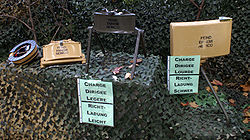Directional charge
A directional charge is a horizontally directed fragmentation charge that is used by a manual detonator via an ignition cable, but also by a self-timer, usually as a pull detonator with a trip wire as a landmine against soft and weakly armored targets. The model for the various types of this weapon was the American M18 Claymore .
The difference to a conventional fragmentation mine is that the directional charge can be released by hand and is therefore only effective when there is a military need. It is therefore not a land mine in the sense of the Ottawa Agreement.
construction
A directional charge consists of a plate with pre-fragmented splinters and an explosive charge behind the splinter plate . This combination is placed on a frame and can be carried and triggered by one person. It is triggered electrically manually by an igniter, which is usually connected to the mine by a cable.
Directional charges in the Swiss Army
Technical data for the directional charge (Richt Ldg) 96 light of the Swiss Army :
- Weight: total 2.9 kg
- Explosives: 1.5 kg
- Operating distance: up to 50 m
- Target area: 50 × 2 m
- Total about 920 splinters at 50 m
- 4 splinters per m²
The light directional charge was used as an anti-personnel mine before the ratification of the Ottawa Convention , under the name “Horizontal Personnel Mine 90”. The empty compartment for the tripwire is still in the boxes with the manipulation models.
Technical data for the directional charge (Richt Ldg) 96 heavy of the Swiss Army:
- Weights: total 20 kg
- Explosives: 9.5 kg
- Tripod: 2 kg
- Operating distance: up to 150 m
- Target area: 100 × 4 m
- Total about 1,200 splinters at 150 m
- 2 splinters per m²
The heavy directional charge is used to combat vehicles that are as light as possible. The previous name was "Horizontal Splinter Mine 90".
